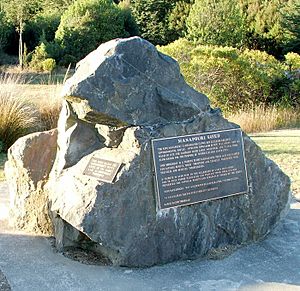Save Manapouri campaign facts for kids

Monument to the Save Manapouri campaign in Manapouri, New Zealand
|
|
| Formation | 1969 |
|---|---|
| Dissolved | 1972 |
| Location | |
| Origins | Environmental campaign to prevent the raising of the levels of lakes Manapouri and Te Anau |
The Save Manapouri campaign was a big effort in New Zealand between 1969 and 1972. Its goal was to stop the water levels of Lake Manapouri and Lake Te Anau from being raised. This was planned as part of building the Manapouri Power Project.
Why the Campaign Started
The original idea for the Manapouri Power Station was to make Lake Manapouri much deeper, by up to 30 metres. This would have also joined Lake Manapouri and Lake Te Anau. People worried this would harm the beautiful lakes.
The Save Manapouri Campaign officially began at a public meeting in Invercargill in October 1969. It quickly became a symbol of growing environmental awareness around the world in the 1960s.
Neville Peat, a writer, explained it well: "At its simplest, the issue was about whether Lake Manapouri should be raised by as much as 30 metres. But there was much more at stake than that. ... What captured the public's imagination across the country was the prospect that a lake as beautiful as Manapouri could be interfered with, despoiled and debased." People were worried about the lake's beauty and also about legal and economic issues.
In 1970, a huge number of New Zealanders, 264,907 people, signed a petition to Save Manapouri. This was almost 10% of the country's population! Even with so many signatures, the government committees decided they had to raise the lake levels. They felt bound by a 1963 law to provide electricity to a company called Comalco (now Rio Tinto Aluminium). This electricity was needed for their aluminium factory at Tiwai Point.
How the Campaign Made a Difference
The future of Lake Manapouri became a major topic in the 1972 New Zealand general election. The Labour Party, led by Norman Kirk, won the election. They had promised to support the Save Manapouri campaign's goals.
In 1973, Prime Minister Kirk kept his promise. He created a special group called the Guardians of Lake Manapouri. This independent group was given the job of looking after the lake levels. They still do this important work today. The first six Guardians were all key leaders from the Save Manapouri Campaign. They included Alan Mark, Ronald McLean, Wilson Campbell, Les Hutchins, John Moore, and Jim McFarlane.
A song called Damn the Dam by John Hanlon was released in 1973. While it was originally about saving energy, it became strongly linked to the Save Manapouri Campaign. Many people now see it as a song celebrating one of New Zealand's longest and most important environmental campaigns.
The Save Manapouri Campaign was even brought back in 1991. Many of the same leaders formed a new group called Power For Our Future. This time, they fought against selling the power station. They wanted to make sure Comalco couldn't try to raise the lake levels again. This campaign was also successful. The government announced that the Manapouri power station would not be sold to Comalco.

